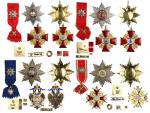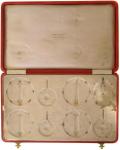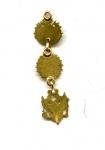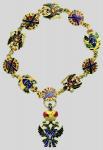-
Posts
22,214 -
Joined
-
Last visited
-
Days Won
68
Content Type
Profiles
Forums
Blogs
Gallery
Events
Store
Everything posted by JapanX
-
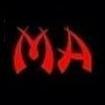
Imperial Russia What you get when St.Andrew is your first Russian Order
JapanX replied to JapanX's topic in Russia: Imperial
-

Imperial Russia What you get when St.Andrew is your first Russian Order
JapanX replied to JapanX's topic in Russia: Imperial
-

Imperial Russia What you get when St.Andrew is your first Russian Order
JapanX replied to JapanX's topic in Russia: Imperial
-

Imperial Russia What you get when St.Andrew is your first Russian Order
JapanX replied to JapanX's topic in Russia: Imperial
-

Imperial Russia What you get when St.Andrew is your first Russian Order
JapanX replied to JapanX's topic in Russia: Imperial
All orders in this set were made by Keibel (we will examine them a little bit later ), the manufacturer of the box is unknown. Here comes another box (empty) from Petrov workshop Cover -

Imperial Russia What you get when St.Andrew is your first Russian Order
JapanX replied to JapanX's topic in Russia: Imperial
-

Imperial Russia A Curious Case of Miniature Collar`s of St. Adrew Order
JapanX replied to JapanX's topic in Russia: Imperial
-

Imperial Russia A Curious Case of Miniature Collar`s of St. Adrew Order
JapanX replied to JapanX's topic in Russia: Imperial
-

Imperial Russia A Curious Case of Miniature Collar`s of St. Adrew Order
JapanX replied to JapanX's topic in Russia: Imperial
This one belonged to John George Lambton, 1st Earl of Durham. Made in St. Petersburg by Wilhelm Kämmerer in 1838. Length of collar (including clasp) 173mm (!!!) -

Imperial Russia St. Andrew Badge: Keibel vs. Eduard
JapanX replied to JapanX's topic in Russia: Imperial
Same here... Between AK and IK quite insignificant differences ... But even two Keibels with AK have small differences As for differences between WK and KK - couldn`t really comment since I didn`t saw WK Andrew`s... Yes, this was one amazing collection! Personally I prefer Pannasch Nevsky over St. Adrew (simply amazing quality!). As for the miniature coller - I think it will be very interesing to discuss these miniature collers in a separate thread Regards, Nick -
Rich, your watch fob is in mint condition - I was talking about the Yokosuka Arsenal Technical Skills badge. The one that started it all. Looks like it was described in two books Cheers, Nick
-
Exactly the same, only in better condition Cheers, Nick
-

Imperial Russia St. Andrew Badge: Keibel vs. Eduard
JapanX replied to JapanX's topic in Russia: Imperial
Hmmm... Around 1050 were issued ... Many were awarded to foreigners. So they are out there somewhere ... At least some of them But I don't think that anyone will try to get one out of Russia for sale ... The real market (with astronomical prices!) for Imperal Russia awards is modern Russia. If in 1990s Russia was net exporter of it's own decoration, than 00s it became net importer :lol: -

Imperial Russia St. Andrew Badge: Keibel vs. Eduard
JapanX replied to JapanX's topic in Russia: Imperial
Yep. No time for being picky... Especially when asked price even for combined sets (for example badge from Eduard, breast star from Keibel and modern box) > $ 100 000 Regards, Nick -
Turns out it was also listed in Paul Murphy and Steven Ackley book “In the Name of Living God", page 55 Cheers, Nick
-
Interesting piece Rich!
-
Ha! Actually it was a short version BACKGROUND: In the late 1800's Japan started an aggressive policy of modernization which included imperialistic, colonial, expansion in order to secure the natural resources needed for the modernization plans. A politically fragmented China, resulting in an ineffective, central government, permitted the Japanese to conduct limited, localized conflicts on Chinese territory and by the early 1930’s Japan had annexed Korea and controlled the Chinese region of Manchuria. On July 7TH 1937 the Marco Polo Bridge, (or alternatively, the Lugou Bridge), Incident erupted into a full scale war between Japan and China. By early 1941 the Japanese occupied large sections of central and northern China although they didn’t have a firm hold on these areas as a result of the mountainous terrain which allowed the Chinese to conduct guerilla warfare and acts of sabotage behind Japanese lines. With this stalemate in China and embargoes imposed by Western nations, primarily the United States, Great Britain, Australia and the Dutch holdings of the Netherlands East Indies the Japanese were faced with potential economic defeat and loss of the occupied territories in China which resulted in the Japanese decision to form a plan of expansion in the south Pacific to take over the British and Dutch territories securing a new supply of natural resources. With this plan of expansion into the south Pacific the Imperial Japanese government, believing that the Americans would come to the assistance of the British, also decided on an advance into the eastern Pacific in an attempt to take American territories by surprise and force the United States into negotiating a separate peace. This mistaken belief led to the Japanese attack on the Americans at Pearl Harbor and eventually to the Japanese defeat in August 1945. Interestingly Japan traditionally reserved gallantry awards for those already killed in battle but with the dire war situation in late 1944 a Japanese Imperial Edict introduced the Rikugun Bukosho, (Distinguished Military Service Medal), in two classes, on December 7TH 1944, for award to recognize gallantry and service in an attempt to raise morale amongst the hard pressed Japanese Military. The Japanese view of gallantry, heroism and self sacrifice would be considered very severe to the West and acts with suicidal consequences were relatively common and death in battle was seen as the highest honor amongst the Japanese military. Although the actual criteria for bestowal of a Distinguished Military Service Medal is unknown certain examples are known such as the award of a 1ST class Distinguished Military Service Medal to Sumi Tadao for shooting down four U.S. B29 bombers and damaging an additional three, over Osaka on a single night in March 1945. Other examples were awarded for ramming enemy aircraft with the Japanese pilots, (hopefully), parachuting to safety. Of Note: Due to the late introduction date and the severe actions required for award of the Distinguished Military Service Medal, it can be assumed that few were actually bestowed."
-
Yep, indeed it could be Chilean. Quite exotic medal bar for Japanese Admiral Unfortunately I don't have a picture of Hokkaido award suspension ... Regards, Nick
-
This badge is completely different story... Made in silver and has interesting design! I'd pay $150 for this one at any time! Anyone? :whistle:
-
Their own description "PHYSICAL DESCRIPTION: Roughly, 2", (5cm), tall, 1 5/8", (4cm), wide, die struck steel construction, first class badge with black, silver and gilt finishes is in the form of a stylized cross flory with a raised, smooth silver washed outer edge encompassing a recessed pebbled background field. The obverse center of the badge features a smaller, embossed, silver washed, stylized cross flory superimposed with a silver washed, vertical spear with an embossed, gilt washed, stylized banner superimposed on the spear with embossed Kanji characters, translated as, Military Merit. The solid, silver washed reverse of the badge has a crimped, soldered hinge on an elongated oval base plate, a wide, tapering vertical pin and a heavy soldered catch also on a elongated oval base plate all intact. The reverse also has embossed Kanji characters which translate as Distinguished Military Service Award. The badge retains about 70% of it’s silver wash, about 45% of it’s black wash and about 30% of it’s gilt wash. The badge also shows some minor pitting which may have been a flaw in the original dies. Rare, late war, Japanese gallantry award."
-
Yep, I know this badge Mickey $7736 for pretty salty (to put it very mildly - 40% of black paint and 30% of gold gilt from obverse are gone, marks of corrosion on reverse and no box) 1st class?! No wonder they couldn't sell it for a loooong time .... By the way, this 1st class was made by same stamp that was used in making my 2nd class Cheers, Nick
-

Imperial Russia Badges for Donations to Development of Aeronautics
JapanX replied to JapanX's topic in Russia: Imperial
-

Imperial Russia Badges for Donations to Development of Aeronautics
JapanX replied to JapanX's topic in Russia: Imperial



